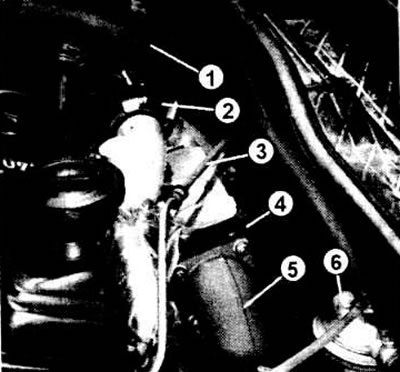Main components
The turbocharger consists of two paddle wheels (turbines), connected by a shaft. Through one turbine, which is called the leading one, a stream of exhaust gases passes, causing it to rotate at a high number of revolutions. At the same time, the second turbine also rotates, sucking air through the air filter and forcing it into the intake manifold. When the intake valve is opened, a portion of air is literally pushed into the cylinder. More fuel can be burned in a larger volume of air, the combustion process in the cylinder when air is injected is also improved. Therefore, from two power units of equal volume, an engine with a turbocharger has more power. Since the exhaust gases are hot, they heat up all parts of the turbocharger. Therefore, for cooling and lubricating the rapidly rotating turbine shaft to the turbocharger, there is an individual oil supply from the system from the small engine.

Turbo diesel engine in section: 1 - drain oil pipeline from the turbocharger: 2 - boost pressure control valve; 3 - turbocharger; 4 - supply oil pipeline to the turbocharger; 5 - valve of the engine crankcase ventilation system; 6 - fuel supply regulator; 7 - inlet pipeline; 8 - boost pressure relief valve

The turbocharger is located on the rear right of the engine: 1. Branch pipe from the air filter to the turbocharger; 2. Branch pipe from the turbocharger to the exhaust pipeline; 3. Supply oil pipeline; 4. Branch pipe of removal of the fulfilled gases; 5. Fuel filter.
Boost pressure regulator
The selected design of the turbocharger has the advantage of providing sufficient boost pressure even at a relatively low speed. Therefore, at high speeds, excess air must be supplied. But then the boost pressure in the system will rise to such an extent that it will harm the engine and shorten its life. In order to avoid such phenomena, the system has a boost pressure regulator.
With an increase in speed, the regulator directs only part of the exhaust gases through the turbine wheel of the supercharger. As a result, the boost pressure is reduced and can no longer rise above the limit value of 0.72 bar.
Boost pressure relief valve
The valve prevents boost pressure from rising above 0.81 bar. if the boost pressure regulator is defective. This valve is located between the air filter and the blower and, when overpressured, allows air to move back to the air filter.
Structural changes in the fuel pump
The air/fuel ratio must be correct regardless of changes in boost pressure. With higher boost pressure, the fuel pump must supply more fuel. To do this, a fuel supply regulator is installed in the fuel pump depending on the boost pressure.
Structural changes in the engine
At first, there were no changes in conventional engines when turbochargers began to be used on cars. Subsequently, stronger piston rings were installed, a crankshaft with hardened connecting rod journals, the engine crankcase, cylinder head and its threaded connections were strengthened. In addition, a new intake manifold was installed.
Engine oil has become better at cooling tasks. In the case of a turbo engine, the bottom of the piston is additionally cooled with oil (thanks to special holes in the connecting rod) and turbocharger. Increased oil pump performance, installed a larger oil cooler. It must be remembered that during a sudden stop of the engine, when the turbine continues to rotate due to inertia at high speeds, and the oil pump does not supply oil (engine off), turbine bearings may burn.
Instruction. What is contraindicated for a turbocharger is the instantaneous stop of the engine after a long drive when the accelerator pedal is fully depressed. In this case, the supercharger can jam: the shaft bearing near the drive turbine wheel is so hot from the exhaust gases. If this phenomenon is often repeated, then the supercharger will soon fail. Therefore, if the car was driving for a long time with a full load (with full throttle), then it is necessary to let the engine idle for 1-2 minutes before stopping.

Visitor comments